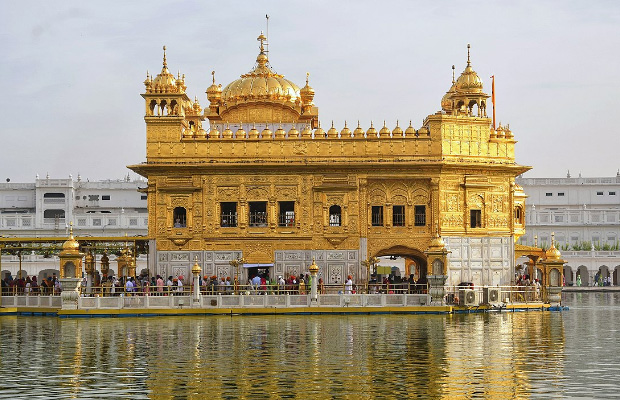
The Golden Temple in Amritsar, or “Harmandir Sahib,” or “Darbar Sahib,” is known to Sikhs across the world as their holiest place of worship. It is a beautiful, sacred place of immense beauty and profound significance. Located in the heart of Amritsar, a city in the Indian state of Punjab, the temple is a symbol of equality, human brotherhood, and unselfish service, besides being a place of worship. Providing a unique spiritual and cultural experience, its peaceful environment, awe-inspiring architecture, and rich history draw millions of pilgrims and travellers every year.
Location:
The Golden Temple is perfectly located in the northern Indian state of Punjab, near the city of Amritsar. It lies in the heart of a huge artificial body of water, known as Amrit Sarovar, most striking feature of this place. This sacred tank is the origin of the name of the city of Amritsar. The temple complex is readily accessible and is the city’s focal point, with a variety of important structures and historical sites surrounding it. The four gates of the complex, facing the cardinal directions, symbolizes the Sikh concept of tolerance and acceptance of people from all walks of life.
History of The Golden Temple:
The Golden Temple’s history demonstrates the foresight and tenacity of the Sikh Gurus and the Sikh people. The 3rd Sikh Guru, Guru Amar Das Ji, started the process of designing a central Sikh sacred site. The duty of excavating the Amrit Sarovar, a holy tank, and constructing a township around it fell to his pupil Bhai Ram Das, who would become the fourth Guru, Guru Ram Das Ji. In 1570, work on the Sarovar began, and the town, then known as Ramdaspur, started to grow.
Guru Arjan Devji, the fifth Sikh Guru, formulated the concept of building a central shrine of worship within the Sarovar. In a remarkable gesture of interfaith reconciliation, he invited Sufi saint Hazrat Mian Mir of Lahore to lay the foundation stone of the temple in 1588 after planning the Harmandir Sahib’s architecture. Once the temple was completed in 1604, Baba Budha Ji, the first Granthi and Guru Arjan Dev Ji installed the Adi Granth, the main scripture of Sikhism, in the temple.
The Golden Temple has gone through several hardships and periods of destruction throughout the years due to Mughal and Afghan military invasions. Although the Sikh community always reconstructed and kept its sacred shrine intact with unending devotion and commitment. Most of the temple’s existing structure was rebuilt during the mid-18th century.
Under the patronage of the Sikh Empire’s founder, Maharaja Ranjit Singh, the temple experienced a turning point in its history at the start of the 19th century. Maharaja Ranjit Singh undertook extensive repairs, and he understood the shrine’s spiritual value and architectural potential. He added marble on the top floors of the temple, and most popularly of all, glided the upper half of the building with nearly 750 kg of pure gold leaf. They established the Harmandir Sahib as an iconic landmark and transformed it into the stunning Golden Temple.
The Golden Temple was affected by more historical events in the 20th century, including the horrific and complex events of 1984. Through the joint efforts and devotion of the Sikh Sangat worldwide, the temple has persistently been repaired and restored in times of turbulence.
Timing:
The Golden Temple is also popular for having a warm environment and ongoing spiritual activities. The holy shrine remains open to guests for most of the day and night, usually from early morning till late evening. The temple generally welcomes devotees and travellers between around 4:00 AM and 11:00 PM; precise times of opening and closing may fluctuate slightly according to season and daily rituals.
There’s a daily schedule of religious rites and rituals that are strictly followed within this broad range. After its morning travel from Akal Takht, the Guru Granth Sahib is placed in the central shrine for the Prakash, inaugurating the day. Asa di Var and Gurbani Kirtan are then sung continuously throughout the day.
There are many readings and prayers taking place throughout the day. Evening prayer or Rehras Sahib is performed in the evening once the sun has set. The Guru Granth Sahib is ritually carried back to the Akal Takht for the night as part of the Sukh-Aasan, which closes the day. The precise timings of these ceremonies, particularly those of Prakash and Sukh-Aasan, are announced at sunrise and sunset timings.
Providing free vegetarian food to all visitors, irrespective of caste, creed, or religion, the Langar is served 24 hours a day and is the backbone of the Golden Temple’s philosophy of equality and service.
Wrapping up –
For Sikhs, the Golden Temple or Sri Harmandir Sahib is a great spiritual hub and a welcoming sanctuary for all. Against the serene Amrit Sarovar in Amritsar, its breathtaking views are an homage to a rich religious heritage, perseverance, and architectural development. It is a symbol of Sikh values of equality and service in the Langar and remains open for longer hours.